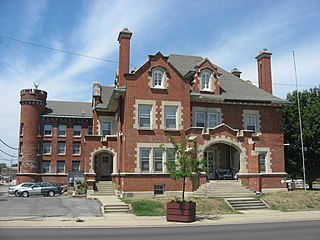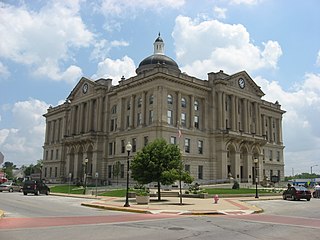
Anderson Downtown Historic District is a national historic district located at Anderson, Madison County, Indiana. The district dates from c. 1887-1955 and encompasses 32 contributing buildings in the central business district of Anderson. Despite some loss of integrity due to demolition and alteration, the district still includes a significant collection of historic and architecturally distinguished commercial buildings. Aside from the usual historic commercial impact of similar districts, this district includes several properties that illustrate Anderson's transportation heritage. Included in the district or nearby are the following individual sites on the National Register of Historic Places: Paramount Theatre, Tower Hotel, Anderson Bank Building, Gruenewald House, and The Anderson Center for the Arts. Additional notable or interesting buildings include the Union Building, the State Theater, the Central Christian Church, the Anderson YMCA, the old post office and the Big Four.

The Old Richmond Historic District is a neighborhood of historic residential and commercial buildings and national historic district located at Richmond, Wayne County, Indiana. The district encompasses 212 contributing buildings located just east of the East Fork of the Whitewater River, comprising some of the earliest extant buildings in Richmond. It developed between about 1816 and 1925 and includes representative examples of Greek Revival, Italianate, and Gothic Revival style architecture. Located in the district is the separately listed Bethel A.M.E. Church. Other notable contributing buildings include the William Paul Quinn House, Elijah Coffin House (1845-1847), Henry Davis House (1856), Rankempf Cottage (1855), Hall Town House (1838), Edward Frauman House (1855), and Lydia Pierce Cottage (1858).

Geneva Downtown Commercial Historic District is a national historic district located at Geneva, Adams County, Indiana, USA. It encompasses 22 contributing buildings in the central business district of Geneva. were built between about 1882 and 1930, and include notable examples of Italianate and Romanesque Revival style commercial architecture. Notable buildings include the M.E. Hutton Carriage Shop (1895-1896), Briggs Hardware (1882), Shamrock Block, and the Independent Order of Odd Fellows building (1906).

Downtown Auburn Historic District is a national historic district located at Auburn, DeKalb County, Indiana. The district encompasses 52 contributing buildings in the central business district of Auburn. The district developed between about 1870 and 1935, and includes notable examples of Victorian, Classical Revival, Romanesque Revival, and Colonial Revival style architecture. Notable buildings include the DeKalb County Courthouse (1911-1914), Henry Opera House (1917), DeKalb County Jail (1918), Commercial Club (1917), Auburn City Hall (1913), South Interurban Station, Dilgard Building, Y.M.C.A. Building (193-1914), Auburn Hotel (1922), U.S. Post Office (1934), and Masonic Temple.

Elkhart Downtown Commercial Historic District is a national historic district located at Elkhart, Elkhart County, Indiana. The district encompasses 59 contributing buildings in the central business district of Elkhart. It was developed between about 1868 and 1930, and includes notable examples of Italianate, Queen Anne, and Classical Revival style architecture. Located in the district are the separately listed Green Block, Lerner Theatre, and Young Women's Christian Association. Other notable buildings include the Cornish Block, Franklin Street Station (1895), Menges Building (1908), former Post Office (1905), Midwest Museum of Modern Art (1922), Elkhart Water Company, Masonic Temple, Rowe Block (1900), and Dreves Building.

Grant County Jail and Sheriff's Residence is a historic county jail and residence located at 215 East 3rd Street in Marion, Grant County, Indiana. It was designed by Richards, McCarty & Bulford and built in 1904. It consists of two distinct units that are constructed of red pressed brick with limestone detailing. The residence is in the Queen Anne style with English Tudor details. It sits on a raised basement and has a bell-cast roof. It has been converted into apartments.

Sheridan Downtown Commercial Historic District is a national historic district located at Sheridan, Hamilton County, Indiana. It encompasses 38 contributing buildings and 1 contributing structure in the central business district of Sheridan. It developed between about 1880 and 1939, and includes notable examples of Italianate and Romanesque Revival style architecture. Notable buildings include the H.J. Thistlethwaite Building (1886), Carnegie library, First Christian Church (1910-1911), Higbee Buggy Company, American State Bank (1914), Stanley Brothers Building, Slliot's Drugstore, Indiana Telephone Company building, and U.S. Post Office (1939-1940).

Huntington Courthouse Square Historic District is a national historic district located at Huntington, Huntington County, Indiana. The district includes 102 contributing buildings and 3 contributing structures in the central business district of Huntington. It developed between about 1845 and 1942 and includes notable examples of Italianate, Queen Anne style architecture in the United States, Romanesque Revival, Neoclassical, and Commercial style architecture. Located in the district are the separately listed Moore/Carlew Building and Hotel LaFontaine. Other notable buildings include the Hotel Huntington (1848), Opera House (1881), Lewis Block, Huntington County Courthouse (1904), old Post Office (1916), Citizens' State Bank, City Hall / Fire Station (1904), Huntington Light and Fuel Building, Our Sunday Visitor building (1926), YMCA (1929), and Huntington Theater.

Gary City Center Historic District is a national historic district located at Gary, Indiana. The district encompasses 60 contributing buildings and 2 contributing sites in Downtown Gary. It developed between about 1906 and 1944 includes notable examples of Tudor Revival, Late Gothic Revival, and Classical Revival style architecture. Notable buildings include the City Hall and Superior Courthouse (1927), the second Gary Land Company Building, Olympic Hotel, the "Modern Apartments", Dalton Apartments, Gary State Bank Building (1929), Hotel Gary (1926), City Methodist Church (1926), YWCA Building (1922), and former U.S. Post Office Building (1936).
Hohman Avenue Commercial Historic District is a national historic district located at Hammond, Lake County, Indiana. The district encompasses 15 contributing buildings in the central business district of Hammond. It developed between about 1904 and 1956, and includes notable example of Romanesque Revival, Classical Revival, and Colonial Revival style architecture. Notable buildings include Knott's Apartments (1904), Emmerling Ambulance Garage (1918), Emmerling Building (1918), St. Joseph's Roman Catholic Church Complex, LaSalle Hotel, OK Building (1913), and the Hammond National Bank.

Franklin Street Commercial Historic District is a national historic district located at Michigan City, LaPorte County, Indiana. The district encompasses 73 contributing buildings and 1 contributing object in the central business district and surrounding residential section of Michigan City. It developed between about 1875 and 1955, and includes examples of Italianate, Gothic Revival, Queen Anne, Classical Revival, and Tudor Revival style architecture. Located in the district is the separately listed Michigan City Post Office (1909-1910). Other notable buildings include the Staiger House, Earl House, M & M Diner (1955), Zorn Building (1907), St. Paul's Lutheran Church (1876) and rectory (1888), First Federal Savings Bank, Aicher Block (1914), Brinkman Building, Trinity Episcopal Church (1889), Merchants National Bank Building (1926), Ledbetter Building (1908), Rodenbeck Saloon, First Methodist Episcopal Church (1922), Barker Hall (1929), Masonic Temple (1922-1923), and the Salvation Army Building (1925).
Mitchell Downtown Historic District is a national historic district located at Mitchell, Lawrence County, Indiana.

Argos Downtown Historic District is a national historic district located at Argos, Marshall County, Indiana. The district encompasses 21 contributing buildings in the central business district of Argos. It developed between about 1867 and 1942, and includes examples of Italianate, Romanesque Revival, and Neoclassical style architecture. Notable buildings include the Reed Block (1891), Williams Inn (1838), IOOF #263 Hall (1901-1907), Corner Hardware Building (1883), Argos Reflector Building / GAR Hall, Argos Theater, Sarber Building (1892-1898), Old Argos Opera House / Huff Block (1887-1892), Pickerl Block, Argos Municipal Building (1940), Farmers State Bank Block (1917), Argos Masonic Lodge #399 / Grossman Building (1906), Schoonover Building, and Pickerl Residence.

North Washington Street Historic District is a national historic district located in the city of Bloomington of Monroe County, Indiana. The district encompasses 35 contributing buildings and 6 contributing structures in a predominantly residential section of Bloomington. It developed between roughly 1870 and 1929, and includes notable examples of Queen Anne, Classical Revival, and Bungalow/American Craftsman style architecture. Located in the district is the separately listed Morgan House. Other notable buildings include the Showers-Graham House, Showers-Myers House, Teter House, and Washington Terrace Apartments (1929).

Ellettsville Downtown Historic District is a national historic district located at Ellettsville, Monroe County, Indiana. The district encompasses 50 contributing buildings in the central business district and surrounding residential sections of Ellettsville. It developed between about 1840 and 1953, and includes notable examples of Queen Anne, Early Commercial, Gothic Revival, and Bungalow/American Craftsman style architecture. Notable buildings include the Robert Stimson House, May Presley House, Bradford House, George W. Fletcher House, Wickens House (1909), Capt. Gilbert Perry House, I.O.O.F. Building, Town Hall (1927), Masonic Building (1895), Knights of Pythias Building, First United Methodist Church (1900), and First Baptist Church (1909).

Martinsville Commercial Historic District is a national historic district located at Martinsville, Morgan County, Indiana. The district encompasses 75 contributing buildings and 1 contributing object in the central business district of Martinsville. It developed between about 1847 and 1947, and includes notable examples of Italianate, Classical Revival, and Tudor Revival style architecture. Located in the district are the separately listed Morgan County Courthouse and Blackstone House and Martinsville Telephone Company Building. Other notable buildings are the Martinsville Public Library, Martinsville City Hall (1917), Martinsville Post Office, Pitkin Building, Barskin's Department Store (1922), Indiana Theater, Steven's House / Building, Hale Building, Interurban Station, Union Block (1866), and First Christian Church (1891) and Annex (1927).

Rockville Historic District is a national historic district located at Rockville, Parke County, Indiana. The district encompasses 210 contributing buildings, 3 contributing structures, and 1 contributing object in the central business district and surrounding residential sections of Rockville. It developed between about 1826 and 1942, and includes notable examples of Italianate, Colonial Revival, and Queen Anne style architecture. Notable contributing resources include the Parke County Courthouse (1882), Memorial Presbyterian Church (1891), Sheriff' Residence and Jail, U.S. Post Office (1938), Rockville Public Library (1916), Methodist Episcopal Church, Rockville Grade School (1941), Parke County Seminary (1839), Rockville Opera House (1912), First National Bank (1907), Judge Samuel Maxwell House, Dr. P.Q. Stryker House (1838), Dr. Harrison J. Rice House (1880), and Dr. Marion Goss House (1907).

Mount Vernon Downtown Historic District is a national historic district located at Mount Vernon, Posey County, Indiana. The district encompasses 39 contributing buildings, 2 contributing sites, 1 contributing structure, and 2 contributing objects in the central business district of Mount Vernon. It developed between about 1850 and 1953, and includes notable examples of Italianate, Queen Anne, Romanesque Revival, and Classical Revival style architecture. Located in the district is the separately listed Posey County Courthouse Square. Other notable contributing resources include the McFadin Cemetery, Sherburne Park, the Armory (1922), the Alexandrian (Carnegie) Library (1905), City Hall (1893), Fogas Building (1880), Eagles Home (1917), Palace Soda Shop, Memorial Coliseum (1925), and the Opera House (1879).

Farmland Downtown Historic District is a national historic district located at Farmland, Randolph County, Indiana.

Shortridge–Meridian Street Apartments Historic District is a national historic district located at Indianapolis, Indiana. The district encompasses 136 contributing buildings in a predominantly residential section of Indianapolis. It was developed between about 1900 and 1951, and includes representative examples of Colonial Revival, Classical Revival, Late Gothic Revival, Mission Revival, Renaissance Revival, Bungalow / American Craftsman, and Art Deco style architecture. Located in the district is the separately listed Shortridge High School. Other notable buildings include the Vernon Court Apartments (1928), Fronenac Apartments (1951), Biltmore Apartments (1927), Meridian Apartments (1929), New Yorker Apartments (1917), Howland Manor (1929), Powell-Evans House (1911), Harms House (1906), Dorchester Apartments (1921), and Martin Manor Apartments (1916).






















